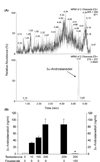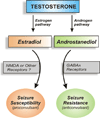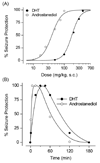Mass spectrometric assay and physiological-pharmacological activity of androgenic neurosteroids
- PMID: 17624627
- PMCID: PMC2390862
- DOI: 10.1016/j.neuint.2007.05.019
Mass spectrometric assay and physiological-pharmacological activity of androgenic neurosteroids
Abstract
Steroid hormones play a key role in the pathophysiology of several brain disorders. Testosterone modulates neuronal excitability, but the underlying mechanisms are obscure. There is emerging evidence that testosterone-derived "androgenic neurosteroids", 3alpha-androstanediol and 17beta-estradiol, mediate the testosterone effects on neural excitability and seizure susceptibility. Testosterone undergoes metabolism to neurosteroids via two distinct pathways. Aromatization of the A-ring converts testosterone into 17beta-estradiol. Reduction of testosterone by 5alpha-reductase generates 5alpha-dihydrotestosterone, which is then converted to 3alpha-androstanediol, a powerful GABA(A) receptor-modulating neurosteroid with anticonvulsant properties. Although the 3alpha-androstanediol is an emerging neurosteroid in the brain, there is no specific and sensitive assay for determination of 3alpha-androstanediol in biological samples. This article describes the development and validation of mass spectrometric assay of 3alpha-androstanediol, and the molecular mechanisms underlying the testosterone modulation of seizure susceptibility. A liquid chromatography-tandem mass spectrometry assay to measure 3alpha-androstanediol is validated with excellent linearity, specificity, sensitivity, and reproducibility. Testosterone modulation of seizure susceptibility is demonstrated to occur through its conversion to neurosteroids with "anticonvulsant" and "proconvulsant" actions and hence the net effect of testosterone on neural excitability and seizure activity depends on the levels of distinct testosterone metabolites. The proconvulsant effect of testosterone is associated with increases in plasma 17beta-estradiol concentrations. The 5alpha-reduced metabolites of testosterone, 5alpha-dihydrotestosterone and 3alpha-androstanediol, had powerful anticonvulsant activity. Overall, the testosterone-derived neurosteroids 3alpha-androstanediol and 17beta-estradiol could contribute to the net cellular actions of testosterone in the brain. Because 3alpha-androstanediol is a potent positive allosteric modulator of GABA(A) receptors, it could serve as an endogenous neuromodulator of neuronal excitability in men. The 3alpha-androstanediol assay is an important tool in this area because of the growing interest in the potential to use adjuvant aromatase inhibitor therapy to improve treatment of epilepsy.
Figures





Similar articles
-
Testosterone modulation of seizure susceptibility is mediated by neurosteroids 3alpha-androstanediol and 17beta-estradiol.Neuroscience. 2004;129(1):195-207. doi: 10.1016/j.neuroscience.2004.08.002. Neuroscience. 2004. PMID: 15489042
-
A high-performance liquid chromatography-tandem mass spectrometry assay of the androgenic neurosteroid 3alpha-androstanediol (5alpha-androstane-3alpha,17beta-diol) in plasma.Steroids. 2005 Dec 1;70(13):879-85. doi: 10.1016/j.steroids.2005.05.007. Epub 2005 Jul 22. Steroids. 2005. PMID: 16040068
-
Aromatase inhibition by letrozole attenuates kainic acid-induced seizures but not neurotoxicity in mice.Epilepsy Res. 2018 Jul;143:60-69. doi: 10.1016/j.eplepsyres.2018.04.004. Epub 2018 Apr 9. Epilepsy Res. 2018. PMID: 29665500
-
The role of neurosteroids and non-genomic effects of progestins and androgens in mediating sexual receptivity of rodents.Brain Res Brain Res Rev. 2001 Nov;37(1-3):201-22. doi: 10.1016/s0165-0173(01)00119-9. Brain Res Brain Res Rev. 2001. PMID: 11744087 Review.
-
The testosterone metabolite and neurosteroid 3alpha-androstanediol may mediate the effects of testosterone on conditioned place preference.Brain Res Brain Res Rev. 2001 Nov;37(1-3):162-71. doi: 10.1016/s0165-0173(01)00116-3. Brain Res Brain Res Rev. 2001. PMID: 11744084 Review.
Cited by
-
Allosteric Modulation of Muscarinic Receptors by Cholesterol, Neurosteroids and Neuroactive Steroids.Int J Mol Sci. 2022 Oct 28;23(21):13075. doi: 10.3390/ijms232113075. Int J Mol Sci. 2022. PMID: 36361865 Free PMC article. Review.
-
Neuroactive steroid levels and cocaine use chronicity in men and women with cocaine use disorder receiving progesterone or placebo.Am J Addict. 2019 Jan;28(1):16-21. doi: 10.1111/ajad.12828. Epub 2018 Dec 11. Am J Addict. 2019. PMID: 30537098 Free PMC article. Clinical Trial.
-
Variation in genes encoding the neuroactive steroid synthetic enzymes 5α-reductase type 1 and 3α-reductase type 2 is associated with alcohol dependence.Alcohol Clin Exp Res. 2011 May;35(5):946-52. doi: 10.1111/j.1530-0277.2010.01425.x. Epub 2011 Feb 15. Alcohol Clin Exp Res. 2011. PMID: 21323680 Free PMC article.
-
Role of hormones and neurosteroids in epileptogenesis.Front Cell Neurosci. 2013 Jul 31;7:115. doi: 10.3389/fncel.2013.00115. eCollection 2013. Front Cell Neurosci. 2013. PMID: 23914154 Free PMC article.
-
Neurosteroids: endogenous role in the human brain and therapeutic potentials.Prog Brain Res. 2010;186:113-37. doi: 10.1016/B978-0-444-53630-3.00008-7. Prog Brain Res. 2010. PMID: 21094889 Free PMC article. Review.
References
-
- Azzolina B, Ellsworth K, Andersson S, Geissler W, Bull HG, Harris GS. Inhibition of rat 5α-reductases by finasteride: evidence for isozyme differences in the mechanism of inhibition. J Steroid Biochem Mol Biol. 1997;61:55–64. - PubMed
-
- Bäckström T. Epileptic seizures in women related to plasma estrogen and progesterone during the menstrual cycle. Acta Neurol Scand. 1976;54:321–347. - PubMed
-
- Bauer J, Stoffel-Wagner B, Flugel D, Kluge M, Schramm J, Bidlingmaier F, Elger CE. Serum androgens return to normal after temporal lobe epilepsy surgery in men. Neurology. 2000;55:820–824. - PubMed
-
- Belelli D, Bolger MB, Gee KW. Anticonvulsant profile of the progesterone metabolite 5α-pregnan-3α-ol-20-one. Eur J Pharmacol. 1989;166:325–329. - PubMed
-
- Beyenburg S, Stoffel-Wagner B, Watzka M, Blumcke I, Bauer J, Schramm J, Bidlingmaier F, Elger CE. Expression of cytochrome P450scc mRNA in the hippocampus of patients with temporal lobe epilepsy. Neuroreport. 1999;10:3067–3070. - PubMed
Publication types
MeSH terms
Substances
Grants and funding
LinkOut - more resources
Full Text Sources
Other Literature Sources

